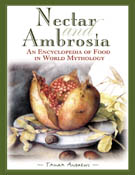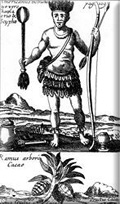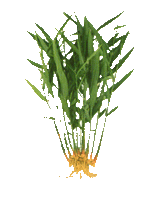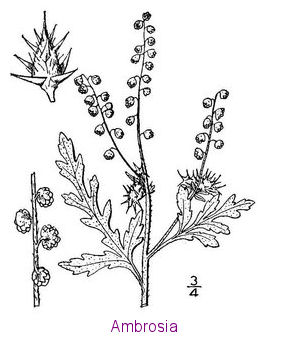|


Foods and Mythologies
by William Doty, Ph. D.,
William Doty, Ph.D. is Professor Emeritus of Humanities and Religious Studies at the University of Alabama and former
editor of Mythosphere: A Journal for Image, Myth and Symbol. Dr. Doty is a prolific writer, translator, and
editor who has published more than twenty books and seventy essays in a wide range of journals on topics including
religious studies, anthropology, psychology, classics, and art criticism. His best known books include Mythography:
The Study of Myths and Rituals, Myths of Masculinity, and Myth: A Handbook.
 Any question that there are infinitely manifold ways in which foods surface in the mythologies of the world is banished by Tamra Andrews, Nectar and Ambrosia: An Encyclopedia of Food in World Mythology (Santa Barbara: ABC-CLIO, 2000). One of a series of reference works, Nectar follows Andrews's Legends of the Earth, Sea, and Sky: An Encyclopedia of Nature Myths (same publisher, 1998), and is as broad in scope. From Acorns to Yogurt, this volume has many topics, although few (alas) overall integrative entries, preferring instead dictionary-like mini-essays around such food stuffs as apricots, guinea pigs, lettuce, onions, radishes, and vanilla. Any question that there are infinitely manifold ways in which foods surface in the mythologies of the world is banished by Tamra Andrews, Nectar and Ambrosia: An Encyclopedia of Food in World Mythology (Santa Barbara: ABC-CLIO, 2000). One of a series of reference works, Nectar follows Andrews's Legends of the Earth, Sea, and Sky: An Encyclopedia of Nature Myths (same publisher, 1998), and is as broad in scope. From Acorns to Yogurt, this volume has many topics, although few (alas) overall integrative entries, preferring instead dictionary-like mini-essays around such food stuffs as apricots, guinea pigs, lettuce, onions, radishes, and vanilla.
The last-named is a favorite of mine, simply because in the greenhouses where I have worked for decades as a volunteer and board member of the Friends of the University of Alabama Arboretum, we have produced vanilla orchids (V. planifolia spec.)...and because getting from the bland pods through the careful long curing process, in which the vanilla flavor appears, apparently was developed for the first time by the Mesoamerican Aztecs. We have followed them in "sweating," namely putting the seed pods out in the warmth of the day, and then wrapping them at night for over twenty days, before carefully drying them. The scent they give off then is amazing.
 And the name is from a goddess, Xanath, who was forbidden conjugation with the mortal she fell in love with, yet continued to provide his people with the flavoring for their favorite chocolate drinks, bringing them great happiness (Andrews 235). Two species of bees and hummingbirds are required for pollination, and it took modern folks many years before they learned how to play Nature to bring those expensive long dried pods into supermarket plastic vials. Europeans in particular insist upon infusing the flavor into ground sugar before considering it "authentico" flavoring in cooked foods. And the name is from a goddess, Xanath, who was forbidden conjugation with the mortal she fell in love with, yet continued to provide his people with the flavoring for their favorite chocolate drinks, bringing them great happiness (Andrews 235). Two species of bees and hummingbirds are required for pollination, and it took modern folks many years before they learned how to play Nature to bring those expensive long dried pods into supermarket plastic vials. Europeans in particular insist upon infusing the flavor into ground sugar before considering it "authentico" flavoring in cooked foods.
The apricot is likely the kind of "apple" (a generic term, applied to a number of different kinds of tree fruits) that tempted Eve in the Garden (10). And lettuce was soulfully eaten in the ancient Middle East as a mourning reminiscence of its role in the death of Adonis. Egyptians associated the plant with the fertility deity Min, as I well remember from viewing the tombs of nobles in that land. Perhaps the association is with the milky/semen-like juice of the plant or the appearance of the plants, which especially when young can resemble either human penis or vulva (130).
Guinea pigs (cuyes), considered a cute entertainment for children in North America, were a primary source of animal protein across ancient South America, having been domesticated as early as 5600 BCE (111). From then to now: in the Andes yet today, they have an important part in future-telling, diagnosing disease—the cuy is rubbed on the patient's body, and then split open, its organs said to resemble the patient's.
Maple syrup has been harvested by Native Americans for thousands of years, originally with the Ojibwa, Cree, Iroquois, and Algonquin folks in "New England." It was considered more or less the blood of nature and an important symbol of the upsurging life-force of spring (141).
Swearing by onions? And leeks? Well, these were one of the earliest types of plants cultivated. Symbolism includes the (to some) offensive scents, as well as the pearl-in-the-oyster concept of enfolding major significances down theah. In fact, for the Druids and ancient Egyptians, each layer of the root represented a layer of the known-worlds, and one swore oaths with one's right hand on one, considered as a token of eternity (164). Today I'm most fond of slowly simmered leeks with anchovy dressing.
Garlic had its problems because of its strong aromas: in Zoroastrian myth, the god of light, Ahura Mazda, smelled delightful, but his evil counterpart, Ahriman smelled like a garlic bulb, "putrid and rotten" (99). Poor onion relatives, they have often been thought of negatively in mythological terms, considered polluting in more than one culture. Certainly apotropaic (averting evil), as I recall from my childhood in New Mexico, where during winter months, children sometimes appeared in classrooms with a large clove strung on a string around the neck.
 Ginger, on the other hand, was considered the herb of paradise, and was cultivated in the Far East since antiquity as something that brought one close to the deities, and used to flavor meats, oils, tea, and wine (100). It was linked with the solar fire, as was cinnamon, and it was one of the key ingredients of magical practices, including love-lore. Ginger, on the other hand, was considered the herb of paradise, and was cultivated in the Far East since antiquity as something that brought one close to the deities, and used to flavor meats, oils, tea, and wine (100). It was linked with the solar fire, as was cinnamon, and it was one of the key ingredients of magical practices, including love-lore.
Some odd things, from our perspective: radishes were earlier cultivated not for their delightful finish to a good tossed salad, but for the oil that could be processed from their seeds (195). And hazelnuts (seldom seen in the American Southeast) have associations with fertility, even immortality in Europe, where they are much more likely to be associated with candy and desserts than almonds or walnuts. They were also associated with romantic life, birth, and lightning—all aspects of fertility (113)—and indeed served as the symbolic image of the Teutonic god Thor.
Andrews' book encompasses a mass of research into food products, far beyond the references (157-58) to Nectar and Ambrosia. Reference to such elite foods appear in several cultures, and often implicate produce from the axis mundi or Tree of Life, a mythological figure found repeatedly in world mythologies. There are many connections with the Indian soma, and to mystical interpretations of honey, manna, and milk, in other cultures.
But then, hey, the yogurt my father's sister discovered as a magical food in L. A. in the 50's had been cultivated since the Neolithic Age (250). Today's health-food nostrums probably had some mythological sanctioning somewhere along the historical trail. I remember an all-lettuce cure for cancer a friend tried out.
 The nectar (I'd prefer transcription from the Greek: nektar) and ambrosia of Ms. Andrews' title? Well, distinguishing them is a real prob: "In some myths, ambrosia was food and nectar was drink; in other myths, it was the other way around" (157). At any rate, current use of ambrosia to name a fruit salad with shredded coconut is only a rip-off name for what was usually more of a porridge incorporating barley and cheese along with honey, fruit, and olive oil. And of course those ingredients—given our vegetarian/vegan food climate—probably did in a sense prolong the life of mortals. But now that's probably irrelevant to the long lives of "immortals," critters now reduced to blow-up balloons in Macy's Thanksgiving parades, or where I live, the drive-through Christmas nativity scenes that include the three crosses of the Passion story.
The nectar (I'd prefer transcription from the Greek: nektar) and ambrosia of Ms. Andrews' title? Well, distinguishing them is a real prob: "In some myths, ambrosia was food and nectar was drink; in other myths, it was the other way around" (157). At any rate, current use of ambrosia to name a fruit salad with shredded coconut is only a rip-off name for what was usually more of a porridge incorporating barley and cheese along with honey, fruit, and olive oil. And of course those ingredients—given our vegetarian/vegan food climate—probably did in a sense prolong the life of mortals. But now that's probably irrelevant to the long lives of "immortals," critters now reduced to blow-up balloons in Macy's Thanksgiving parades, or where I live, the drive-through Christmas nativity scenes that include the three crosses of the Passion story.
There were other magical potions in cultures other than the Greek, the ambrosia tree of India, for instance, termed "the Cloud Tree, the Tree of Wisdom, or the Tree of Buddha" (158). And that's already a distance from the churning of the amrita of the ocean in the Hindu myth of the birth of the moon god Chandra—later known as Soma. How wonderful to think of the periodically-full moon literally dripping this magical substance down to mere mortals on our daily plane of existence!
One can imagine a whole series of courses on mythological foods and related materials. But then I love to cook and explore recipes. Perhaps others would just like to know the underlying legends, and Nectar and Ambrosia is a good place to begin one's wool-gathering.
Return to Passages Menu
Subscribe to the Passages e-zine
|

